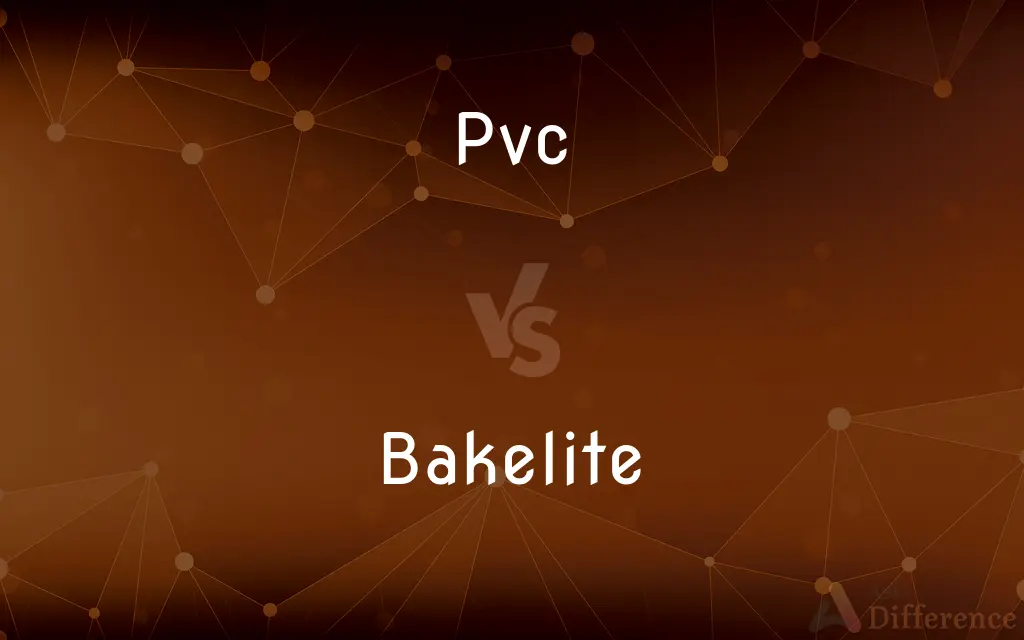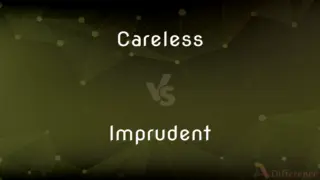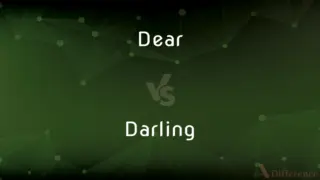Pvc vs. Bakelite — What's the Difference?
Edited by Tayyaba Rehman — By Urooj Arif — Updated on March 30, 2024
PVC, or Polyvinyl Chloride, is a versatile plastic used in construction and pipes, while Bakelite is an early plastic, known for electrical insulation and heat-resistant properties.

Difference Between Pvc and Bakelite
Table of Contents
ADVERTISEMENT
Key Differences
PVC, a synthetic plastic polymer, is widely recognized for its durability, resistance to environmental degradation, and versatility in applications ranging from pipes and construction materials to clothing and healthcare products. On the other hand, Bakelite, the first synthetic plastic, is famed for its excellent electrical insulation properties, heat resistance, and usage in early electrical insulators, radio and telephone casings, and kitchenware.
While PVC can be both rigid and flexible, making it suitable for a broad range of applications, Bakelite is known for its rigidity and inability to melt, which makes it ideal for heat-resistant products and electrical components. PVC's flexibility is attributed to the addition of plasticizers, which are not used in Bakelite, contributing to Bakelite's reputation for stability and durability under high temperatures.
The production processes of PVC and Bakelite also differ significantly. PVC is produced through polymerization of vinyl chloride monomers, while Bakelite is created from phenol and formaldehyde under heat and pressure. This difference in manufacturing reflects their distinct chemical structures and properties.
In terms of environmental impact, PVC has faced criticism due to concerns over its production and disposal, which can release harmful chemicals. Bakelite, while not typically recycled due to its cross-linked polymer structure, does not pose the same level of environmental concerns regarding its production.
While PVC continues to be widely used in various industries due to its adaptability and cost-effectiveness, the use of Bakelite has diminished over time, largely replaced by newer plastics that offer similar properties with greater versatility and safety features.
ADVERTISEMENT
Comparison Chart
Composition
Polyvinyl Chloride, a plastic polymer
Phenol-formaldehyde resin
Flexibility
Can be made flexible or rigid
Rigid and hard
Uses
Construction, pipes, medical devices
Electrical insulators, radio casings
Heat Resistance
Variable, can be modified
Naturally high
Environmental Impact
Concerns over production and disposal
Less environmental concern, not recycled
Production Process
Polymerization of vinyl chloride
Polymerization of phenol and formaldehyde
Durability
High, but varies with plasticizers
Extremely durable, does not melt
Electrical Insulation
Good, especially for PVC used in cables
Excellent, historically significant
Compare with Definitions
Pvc
A synthetic plastic polymer used widely in construction.
PVC pipes are common in plumbing.
Bakelite
The first synthetic plastic, made from phenol-formaldehyde.
Bakelite was used in the first plastic telephones.
Pvc
Resistant to water and chemicals.
PVC clothing is water-resistant.
Bakelite
Historically significant in the development of plastics.
Bakelite marks the beginning of the age of plastics.
Pvc
Flexible or rigid material depending on additives.
Flexible PVC is used in electrical cable insulation.
Bakelite
Cannot be melted and reshaped.
Once set, Bakelite products are permanent in shape.
Pvc
Environmentally controversial due to its production.
The production of PVC releases harmful chemicals.
Bakelite
Known for its electrical insulation properties.
Bakelite is used in electrical insulators.
Pvc
Can be clear or colored.
Clear PVC is used for medical tubing.
Bakelite
Heat-resistant and durable.
Bakelite handles are found on a variety of kitchen tools.
Pvc
Irregularity of cardiac rhythm; recurrent occurrences can be a precursor of ventricular fibrillation
Bakelite
Polyoxybenzylmethylenglycolanhydride, better known as Bakelite ( BAY-kə-lyte; sometimes spelled Baekelite), was the first plastic made from synthetic components. It is a thermosetting phenol formaldehyde resin, formed from a condensation reaction of phenol with formaldehyde.
Pvc
A polymer of vinyl chloride used instead of rubber in electric cables
Bakelite
Alternative form of Bakelite
Bakelite
A thermosetting plastic used in electric insulators and for making plastic ware and telephone receivers etc.
Bakelite
A thermosetting plastic used as electric insulators and for making plastic ware and telephone receivers etc.
Common Curiosities
Can PVC be recycled?
Yes, PVC can be recycled, though its recycling process is more complex due to the presence of chlorine and plasticizers.
Why is Bakelite considered historically important?
Bakelite is considered the first synthetic plastic, marking a significant milestone in the development of polymer science.
What makes Bakelite unique among plastics?
Its heat resistance, electrical insulation properties, and the fact that it cannot melt make Bakelite unique.
Can Bakelite be melted down and reshaped?
No, Bakelite cannot be melted and reshaped due to its cross-linked polymer structure.
What is PVC used for?
PVC is used in construction (pipes, fittings), healthcare (tubing, containers), and as insulation for electrical wires.
Is PVC harmful to the environment?
Concerns exist regarding PVC's production and disposal, as it can release harmful chemicals into the environment.
What role did Bakelite play in the electrical industry?
Bakelite's excellent electrical insulation properties made it a material of choice for early electrical applications.
What are the main differences in the production of PVC and Bakelite?
PVC is produced through the polymerization of vinyl chloride, while Bakelite is made from phenol and formaldehyde under heat and pressure.
What are the health concerns associated with PVC?
Health concerns primarily relate to the release of toxic chemicals during PVC production and disposal, including dioxins.
How do environmental concerns differ between PVC and Bakelite?
PVC faces environmental concerns related to its life cycle, including production and disposal. Bakelite does not pose the same level of concern but is not typically recycled.
Why is Bakelite no longer widely used?
Newer plastics offering similar properties with greater versatility and safety have largely replaced Bakelite.
What are plasticizers, and how do they relate to PVC?
Plasticizers are additives that increase the plasticity or fluidity of a material, making PVC flexible for various applications.
How has the use of plastics evolved since Bakelite?
Since Bakelite, the development of plastics has expanded to include a vast range of materials with diverse properties, addressing specific industrial and consumer needs.
How does the flexibility of PVC impact its uses?
The ability to modify PVC's flexibility allows it to be used in a wide range of applications, from rigid construction materials to flexible cables.
What are some common uses of Bakelite today?
Bakelite is still used in some electrical insulators, industrial laminates, and as collectibles in vintage jewelry and radios.
Share Your Discovery

Previous Comparison
Careless vs. Imprudent
Next Comparison
Dear vs. DarlingAuthor Spotlight
Written by
Urooj ArifUrooj is a skilled content writer at Ask Difference, known for her exceptional ability to simplify complex topics into engaging and informative content. With a passion for research and a flair for clear, concise writing, she consistently delivers articles that resonate with our diverse audience.
Edited by
Tayyaba RehmanTayyaba Rehman is a distinguished writer, currently serving as a primary contributor to askdifference.com. As a researcher in semantics and etymology, Tayyaba's passion for the complexity of languages and their distinctions has found a perfect home on the platform. Tayyaba delves into the intricacies of language, distinguishing between commonly confused words and phrases, thereby providing clarity for readers worldwide.














































